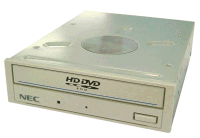Toshiba
HD DVD player vs Sony Blu-ray
Bulletin: RollerTrol™ Automation Systems is Launched!
- We have been busy making and selling roller blinds and projector screens for some time, and we have decided to start selling the components at
RollerTrol.com so others can do the same.
- Take a look at our online store for tubular motors and other associated products - make your own custom shade or screen size
that fits your room perfectly! We also have special motor kits that work with x10 automation systems.
- While you're at it, check out our tubular motors with built-in radio controllers. When used with our multi-channel remotes, you can control the screen AND blackout blinds with a single remote!
End Bulletin: RollerTrol™ Automation Systems
Toshiba has recently
released its first HD DVD player in the high definition DVD format war
with Sony, entering the market ahead of the Sony Blu-ray player. The company announced
2 models: the HD-A1 at $499 and the HD-XA1 at $799. The more expensive HD-XA1 has
enhancements that include a motorized drawer, a backlit remote, a choice of three different user
interfaces, and a pair of USB ports for connecting gaming controllers.
The prices of these units are significantly lower than those of the Blu-ray players
to be released shortly by Sony, but the Sony will have some additional
capabilities that these don't.
 The
lower prices are due largely to the fact that Toshiba is using the older
Intel Pentium 4-M processor that had already been phased out of
production and removed its price lists. The good news is that it keeps
the initial cost down, but the bad news is that these units have a long
startup time and consume a relatively large amount of power at
approximately 80 watts - enough to require a fan. Even worse news is
that the high definition 1080i output is only available through the copy
protected HDMI output. Note that it doesn't have a 1080p output of
any kind, unlike the new Sony BDP-S1 which will support 1080p.
The
lower prices are due largely to the fact that Toshiba is using the older
Intel Pentium 4-M processor that had already been phased out of
production and removed its price lists. The good news is that it keeps
the initial cost down, but the bad news is that these units have a long
startup time and consume a relatively large amount of power at
approximately 80 watts - enough to require a fan. Even worse news is
that the high definition 1080i output is only available through the copy
protected HDMI output. Note that it doesn't have a 1080p output of
any kind, unlike the new Sony BDP-S1 which will support 1080p.
Neither the slow startup time, high power
consumption, or lack of 1080p output would stop me from purchasing the
Toshiba unit immediately, but
the HDMI output restriction certainly has. Here's a brief comparison of
Toshiba's HDA1 HD DVD to Sony's BDP-S1 Blu-ray, from what we know so
far:
| Feature |
Toshiba
HD-A1 |
Sony BDP-S1
|
| Max Resolution |
1080i |
1080p |
| 1080i via Component Output |
No |
Yes |
| upscale regular DVD to 1080i |
Yes (HDMI port) |
Yes (Component & HDMI port) |
| upscale regular DVD to 1080p |
No |
Yes (HDMI port) |
| Approximate Price |
$500 |
$1,000 |
If your HD-capable television or projector does not have an HDMI connection, you can still get
1080i analog output from the new Sony BDP-S1, which allows for HD
capable sets without HDMI to enjoy Blu-ray Disc high def video. The BDP-S1 is also compatible with standard DVDs with the added feature of 1080p upscaling through HDMI, which gives new life to existing DVDs libraries.
I have seen some video samples of HD DVD and I am pleased to say it
looked fabulous, meeting all the expectations I had hoped for. Buying into these new high definition formats will be the
single biggest improvement I could make to my home theater system, and I
had decided to go this route instead of upgrading my BenQ PB 6200
projector, until I realized I would need an HDMI input (High
Definition Multimedia Interface) input connector to view
the high definition output of the player. The highest resolution my projector supports is
1080i (analog component input), and I would be able to enjoy HD movies in that
format, but only if it came through a component video output.
So, I'm going to wait for a
while, to see if there's any way of avoiding the projector upgrade, and
whether or not I will spring for the Sony player (I've certainly been
enjoying their widescreen
1080i high-def camcorder). I
may also build an HTPC and buy an HD DVD drive for it, instead of going
with the discrete component approach. Note that Toshiba is about
to release the first laptop (Qosmio G30) equipped with an internal
HD DVD drive, so they will no doubt have the raw drives available soon
(and
NEC is also releasing an HD-DVD burner). I may also wait and get a Playstation
3 (it has a Blu-ray drive). Another direction I'm considering is
internet movie downloads and
content providers, now that the fantastic
new AVC CODEC has arrived.
Apparently, both Toshiba players (and all forthcoming HD DVD players?) will only output high-definition
1080i video from the copy-protected HDMI outputs, so those of you that
have HDTV sets or projectors (like my BenQ PB 6200), won't be able to enjoy the improved image quality of HD-DVD.
There has been some suggestion that other HD-DVD players or the competing Blu-ray players may still enable high-def output via analog outputs,
so I'll definitely be waiting to see about that. If manufacturers of Blu-ray did allow HD resolutions via analog, it would have one more major
advantage over the less expensive HD-DVD players, but I'll believe it
when I see it, knowing Sony's mania for copy protecting everything it
can.
 So
we know that Toshiba didn't even bother with a component analog output
on their new offering, but what about other manufacturers? Turns out, it
gets worse ... enter the the AACS (Advanced Access
Content System), a copy-protection scheme that is
controlled and enforced by movie studios. The upcoming next-generation optical disc players, including Blu-ray and HD-DVD models, will give studios the option to hobble the resolution of the players' analog outputs.
The eight-company consortium behind AACS, using the mandatory copy-protection system used by both formats,
allows each studio to choose whether to downconvert the output of the players' component-video outputs to
960 x 540 resolution, which is one quarter of the 1,920 x 1,080 resolution of true
high definition HDTV.
So
we know that Toshiba didn't even bother with a component analog output
on their new offering, but what about other manufacturers? Turns out, it
gets worse ... enter the the AACS (Advanced Access
Content System), a copy-protection scheme that is
controlled and enforced by movie studios. The upcoming next-generation optical disc players, including Blu-ray and HD-DVD models, will give studios the option to hobble the resolution of the players' analog outputs.
The eight-company consortium behind AACS, using the mandatory copy-protection system used by both formats,
allows each studio to choose whether to downconvert the output of the players' component-video outputs to
960 x 540 resolution, which is one quarter of the 1,920 x 1,080 resolution of true
high definition HDTV.
This means that HDTVs whose only HD
compatible inputs are component video or analog RGB (like my BenQ PB6200
projector), including approximately 3 million
HDTV display units sold before digital HDMI inputs were available, may not be able to display the full resolution that
next generation players offer. If a movie studio chooses to make it so,
you won't be able to see movies at 1080i resolution, even if the DVD
player has included an analog component output.
Studios can
use AACS to record a 'flag' on the disc (the Image Constraint Token
or 'Managed Copy' system) that tells the player to allow or disallow full-resolution analog signals.
Although no studio has declared publicly that they will be using this
copy protection system, Warner Brothers has been the strongest proponent of the system, and Disney, NBC Universal, and Paramount are also likely to take advantage of it. Sony Pictures
and Universal Studios have recently announced that they will not
be activating the downconversion flag, at least not immediately - so
there is some hope we'll see 1080i coming from Blu-ray discs. Studios will be required to state on the
outside of disc whether downconversion will be forced for that particular title.
I frankly don't think this will stop large scale copying - it will take place regardless of whether the analog outputs are
downconverted, as professional pirates will undoubtedly find a way to do
it with the digital output that doesn't involve recording an analog signal.
The HDCP protocol (High-Bandwidth Digital Content
Protection) which defines the encryption scheme at the heart of
the HDMI copy protection scheme has apparently already been broken, so
all of this additional cost and hassle is probably moot anyway. Princeton mathematics professor Ed Felten
recently published a relatively practical examination of how HDCP can be
foiled, and apparently it has been publicly known since 2001 that the HDCP encryption scheme is
flawed. 
On that note, it is interesting to see that last year a German electronics company
(Spatz) offered two new devices, the "DVI HDCP" and "DVI MAGIC" hardware converters
that foil the movie studios' attempts to prevent high quality video copying.
The converters don't do anything to the HDCP technology normally used to
encrypt the HD signal; instead, it uses the actual HDCP chips usually built into high definition displays, so that HDCP "protected" signal sources uncomplainingly deliver their
signal, thinking that it has been legally decrypted. They then convert
the video signal to RGBHV or unprotected DVI signals.
Enthusiasts like me who bought an HDTV two or three years ago would be
unlikely to buy one of the early next generation players just to watch
downconverted video, and alienating
'bleeding edge' consumers is never a good idea. HD-DVD and Blu-ray
already have enough problems with an already-too-confusing industry that
features incompatible formats with high prices - not to mention competition from standard
upscaled DVD and future internet downloadable alternatives.
I already get amazingly good 1080i results with my upscaling
Zenith DVB 318 DVD player that I bought for a few hundred bucks, and
I'm quite content to continue using this for quite a while until I see a
reasonable upgrade path that doesn't cost me an arm and a leg just
because someone else may be copying DVD's.
Further HD-DVD news:
Microsoft and Toshiba announced earlier in the year that the two companies
have entered into a cross-licensing agreement that allows them to utilize each other's patents on electronics technologies.
This has created two interesting developments in the HD DVD saga:
Toshiba intends to use Microsoft Windows software in its HD DVD players in hopes of reducing development costs,
and Microsoft is planning to put HD DVD players in future production
releases of its Xbox 360 gaming
system. This will certainly put the Xbox
in a much better competitive position against the new Sony PS3 gaming
system (scheduled for release in November), which already supports
Blu-ray HD DVD. Meanwhile, Microsoft is busily embedding the already
broken HDCP copy protection protocol into every aspect of its new Vista
operating system that will support HD content.
The second HD DVD player to be released in the US looks to be a machine from
RCA, according to the Wal-Mart website. The RCA HDV500 machine will
supposedly ship on 18 May, almost a month after Toshiba's HD-A1 and HD-XA1 players
US launch. RCA showed the slimline HDV5000 at the CES show in Las Vegas
in January, but it appears to have undergone a redesign since then,
looking more like the bulkier Toshiba player.
HD-DVD and Blu-ray Content News:
 So what will we be able to watch? Universal Studios, with 14 officially announced
HD DVD titles is a strong supporter of the HD-DVD format. So far, it is the only major Hollywood studio that is going
HD DVD exclusively.
So what will we be able to watch? Universal Studios, with 14 officially announced
HD DVD titles is a strong supporter of the HD-DVD format. So far, it is the only major Hollywood studio that is going
HD DVD exclusively.
In a recent press release, it was announced that 'The Bourne Supremacy' will be the first title to
make use of the benefits of the special features of the HD DVD format.
The Bourne Supremacy DVD will be the first film from Universal to introduce
a new interactive feature called "Bourne Instant Access," a feature
length picture-in-picture presentation that simultaneously transports viewers
behind the scenes with the cast and filmmakers, all without leaving the movie experience.
In a recent press release, Universal announced that all HD DVDs will showcase enhanced interactive menus that allow viewers to easily navigate and access any menu option at any time while the movie is
playing.
Soon, the second wave of HD-DVD titles from Warner Bros. will hit
stores:
May 2nd: "Swordfish" and "Goodfellas."
May 9th: "Training Day" and "Rumor Has it" which will be the first hybrid disc for the format.
What is a 'hybrid disc'? The release of the first hybrid title, Rumor Has It,
contains both the HD DVD and regular DVD format, giving consumers the greatest flexibility in viewing
options. If you own an HD DVD player, you'll get all the benefits of HD DVD
(but only if your set has an HDMI input), and you'll be able to play the disc in existing DVD players. If
you are considering a future purchase of an HD DVD player, you can still enjoy the movie until
you upgrade, then watch it again in high definition mode.
So that also begs the question 'are there going to be dual HD format
players?' The answer is 'yes' - both Samsung and LG have announced
upcoming players that can play either HD-DVD discs or Blu-ray discs.
It's unclear, though, whether these players will support all 3 formats
and play the old regular DVD too.
New Generation Audio
I didn't want to leave out the new developments in the audio side of HD-DVD as I consider it to be literally half of the entire
viewing experience. The Toshiba HDA1 has standard decoders for the
regular Dolby Digital, Dolby Digital Plus and DTS formats found on regular DVD disks, but it
also has decoders for Dolby TrueHD®
(2-channel) and DTS-HD®.
Dolby Digital, Dolby Digital Plus and DTS are audio
compression formats used in standard DVD's where some audio data is lost upon
decompression, although Dolby Digital Plus
brings increased realism and sound
detail to soundtracks.
Dolby
TrueHD and DTS-HD, used in the new
HD-DVD and Bluray formats are lossless, where audio reproduction is bit-for-bit
identical to the high definition studio master
recordings.
* * * * *
|
|


 The
lower prices are due largely to the fact that Toshiba is using the older
Intel Pentium 4-M processor that had already been phased out of
production and removed its price lists. The good news is that it keeps
the initial cost down, but the bad news is that these units have a long
startup time and consume a relatively large amount of power at
approximately 80 watts - enough to require a fan. Even worse news is
that the high definition 1080i output is only available through the copy
protected HDMI output. Note that it doesn't have a 1080p output of
any kind, unlike the new Sony BDP-S1 which will support 1080p.
The
lower prices are due largely to the fact that Toshiba is using the older
Intel Pentium 4-M processor that had already been phased out of
production and removed its price lists. The good news is that it keeps
the initial cost down, but the bad news is that these units have a long
startup time and consume a relatively large amount of power at
approximately 80 watts - enough to require a fan. Even worse news is
that the high definition 1080i output is only available through the copy
protected HDMI output. Note that it doesn't have a 1080p output of
any kind, unlike the new Sony BDP-S1 which will support 1080p. So
we know that Toshiba didn't even bother with a component analog output
on their new offering, but what about other manufacturers? Turns out, it
gets worse ... enter the the AACS (Advanced Access
Content System), a copy-protection scheme that is
controlled and enforced by movie studios. The upcoming next-generation optical disc players, including Blu-ray and HD-DVD models, will give studios the option to hobble the resolution of the players' analog outputs.
The eight-company consortium behind AACS, using the mandatory copy-protection system used by both formats,
allows each studio to choose whether to downconvert the output of the players' component-video outputs to
960 x 540 resolution, which is one quarter of the 1,920 x 1,080 resolution of true
high definition HDTV.
So
we know that Toshiba didn't even bother with a component analog output
on their new offering, but what about other manufacturers? Turns out, it
gets worse ... enter the the AACS (Advanced Access
Content System), a copy-protection scheme that is
controlled and enforced by movie studios. The upcoming next-generation optical disc players, including Blu-ray and HD-DVD models, will give studios the option to hobble the resolution of the players' analog outputs.
The eight-company consortium behind AACS, using the mandatory copy-protection system used by both formats,
allows each studio to choose whether to downconvert the output of the players' component-video outputs to
960 x 540 resolution, which is one quarter of the 1,920 x 1,080 resolution of true
high definition HDTV.
 So what will we be able to watch? Universal Studios, with 14 officially announced
HD DVD titles is a strong supporter of the HD-DVD format. So far, it is the only major Hollywood studio that is going
HD DVD exclusively.
So what will we be able to watch? Universal Studios, with 14 officially announced
HD DVD titles is a strong supporter of the HD-DVD format. So far, it is the only major Hollywood studio that is going
HD DVD exclusively.